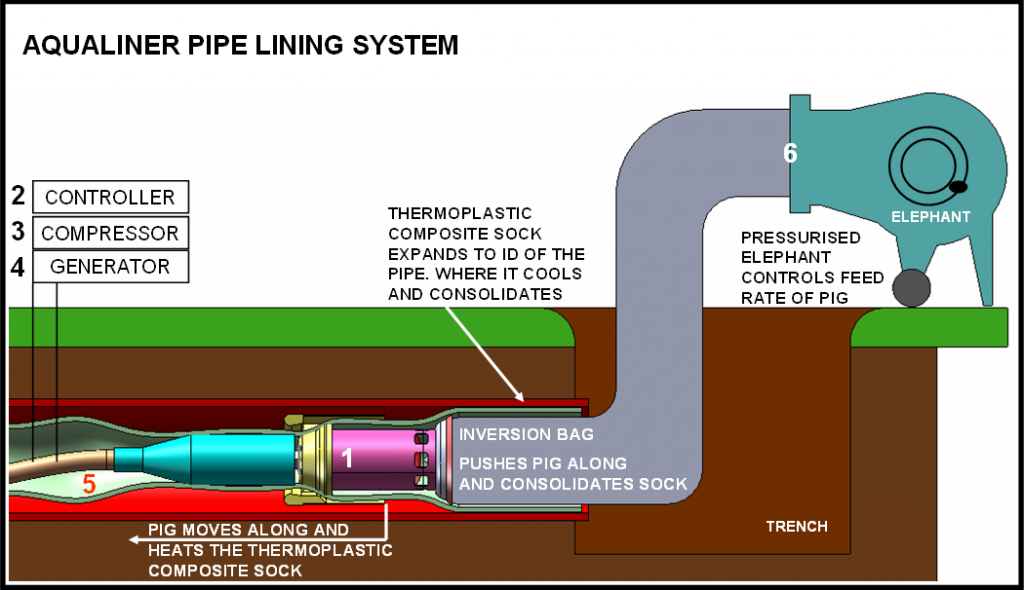Our company is working in Russia on the implementing pipelines restoration technology with using composite materials developed
by Aqualiner Ltd. in UK.
[columns] [column layout=”two”] [/column]
[column layout=”two”]
[/column]
[column layout=”two”]
Developed in one of the research centres of England composite material based on fiberglass with polymeric extenders protects the pipeline from any deterioration and further destruction and thus to withstand the operating pressure as independent structural material.
The composite is formed as a woven material that is sewed on the sewing machine as a sleeve. Then sleeve is dragged into the pipeline. Successively introduced into the sleeve electric “pig” welds composite sleeve to the inner surface of pipelines at a temperature of 200 degrees Celsius. Thealloycanwithstandpressuresupto 60 atmospheres!
The technology allows the robot to carry out a butt joint inside bends by trenchless technology that allows you to sanitize not only pipelines, but also pipeline networks.
The material withstands high loads and tear, which is especially important in mobile soil. Any pipelines are subject to be repaired by such technology. The material is bulletproof.
Method cost is comparable to other technologies, in some cases, twice cheaper.[/column] [/columns]
This composite material is developed as a substitute for metal and as such exceeds many of its characteristics, particularly tensile and tearing.
The fact proving the high efficiency of the method is that a month later after the research completion, Japan, Germany and the USA bought license for this technology.
***
To conclude this review, it is worth noting that the cost of rehabilitation of worn pipes is below the cost of replacing by traditional way in average of 30 – 40% and at the same time the lifespan of existing pipelines extends several times longer. Further significant decline in prices depends on the volume of work.
Since signing the contract period of execution starting from diagnosis of the old pipeline, design stage, coordination and execution of all kinds of work does not take more than 6 months, which in timing is incomparable cost with new construction.
The fact that all the work carried out in the shortest possible time and trenchless technology, is particularly important for the urban environment and the crossing complex communications, roads, water obstacles in the field.
Lining new pipelines in the field is particularly advantageous than the installation of pipes isolated in the factory conditions. Wherein the velocity of pipelines rehabilitation increases significantly.
Today, the main pipeline repair methods are: “pipe in pipe” (relining) and cracking the old pipe with simultaneous broaching new plastic whip. Their specific application of the total weight is more than 90% in comparison with other methods.
Eco Fortis Ltd repairing water and sewer pipes, as well as household, industrial and storm sewer systems (pipes of cast iron, ceramics, steel, acbestos diameter from 80 mm to 315 mm thick-walled plastic pipe).
This equipment is used to repair trench-less pipe diameter Ø 80-280 mm made of steel, cast iron, concrete, reinforced concrete, ceramics, asbestos, plastic.
Are more likely to start work with the method “pipe in pipe” (relining), as the most economical. In the first place, the diameter of the plastic pipe is chosen to be the maximum the diameter of the pipeline to be repaired. Despite the reduction in such instances the inner diameter of the pipeline section to be repaired, its capacity in some cases virtually not reduced due to the low flow resistance of the new plastic pipe.
If holding a trench-less repair method “pipe in pipe” would not create the desired pressure in the repaired section of the pipeline, or increase in diameter requires it applies to the destruction of the old way of the pipe. Work in such cases, our company carries out static cracking. This method has proven successful when working in complex hydro-geological conditions in the immediate vicinity of the repair area other communications structures.
Relining – method of restoring damaged pipelines by means pulling into the damaged pipe polyethylene pipe.
Relining can be:
1. with the destruction of the old pipe “static method” is used in cases when it is necessary to maintain or increase the diameter of the pipeline. In this case, through the frangible tube from the diameter of the well in the well 1 m skipped rod. At the end of the boom in the starting pit knife attached extender, which is connected to the swivel through stretching pipe (usually HDPE). On the part of the receiving pit rod tightened by hydraulic jacks, placed on the bottom of the pit. Hydraulic jacks are mounted on the frame and drives the carriage, which are attached to the rod. The frame has an abutment plate for fixation in the pit. Rod 0.5 m long cycles are removed, and the process continues until the broach cutter output to the receiving pit. In this case the damaged pipe at the same time, cut with a knife, it expands and delayed new pipe.
2. without destroying the old pipe is possible in cases where a slight decrease in the diameter of the pipe or perhaps it is compensated better throughput new polyethylene pipes.
Uses and benefits of trenchless repair
Scope of use:
Update trenchless piping with pipes D = 80-280mm – steel, cast iron (including ductile iron out), plastic, ceramic, cement and so on.
Destruction of short and long pipes: D pipe (long, short) to 280mm.
Destruction gauge diameter pipe to tighten 280mm.
The main advantages of the system:
- High level of performance, thanks to the large level of destructive power and high speed tightening.
- Remote control allows the operator to maintain the system one.
- Stability and structural reliability, even under high loads.
- Simple and reliable connection rods using communication «Quicklock».
- Greater productivity trenchless repair: is a continuous process, connecting rod linkage «Quicklock» does not require screwing.
- HDPE large length tightened directly from the drum or by the “well-well.”
- Locking compound «Quicklock» eliminates slip back spent rods in the old pipeline.



